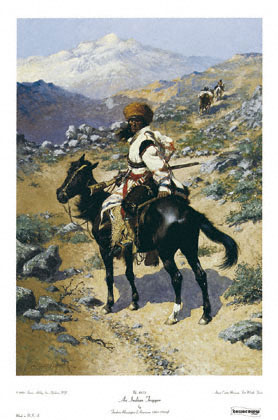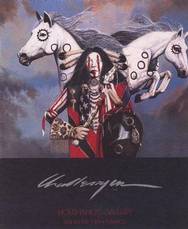The Indian war horse was highly regarded by its American Indian owner, who often honored and protected his war horse by painting tribal symbols upon the animal’s body.
While the symbols used and their meanings varied from tribe to tribe, there were some common symbols that were widely used on the Indian war horse. In this article, you will find explanations of some symbols which Indians used to decorate their war horses.
Each power symbol has its own specific meaning and the purpose for which it was used was determined by the nature of the dangerous job which the war horse would be asked to do.
The Indian would decorate his horse with carefully chosen war symbols or power symbols which might be intended to give him protection, to indicate the troubles which lay ahead, or which spoke of the courageous heart of the war horse. Some symbols told of the horse’s affection for the warrior.
While preparing himself for battle, the Indian warrior would apply his personal honors on
his war horse. The symbols he painted depicted enemies killed and ponies stolen.
The Indian would weave a Medicine Bag into the bridle, and Coup Feathers were braided into the war horse’s forelock and tail.

An Indian Trapper
Buy This Art Print At AllPosters.com
Find out how you can use this image for FREE.
![]()
A circle around the horse’s eye and nostrils for alert vision and a keen sense of smell.
![]()
Arrow points in a line which brought victory.
![]()
Thunder stripes in the horse’s front legs to please the Indian’s god of war.
![]()
Arrowheads on all four hooves made the horse swift and nimble-footed.
![]() Fire Arrows would cause trouble for the enemy, which in turn would add strength to the
Fire Arrows would cause trouble for the enemy, which in turn would add strength to the
warrior.
![]() Right/left hand prints were outlined upon the horse’s chest, which showed that he’d
Right/left hand prints were outlined upon the horse’s chest, which showed that he’d
knocked down an enemy.
![]()
Hail Stones were a prayer for hail to fall on the warrior’s enemy.
![]()
Two crossing bars meant that the horse and his rider had escaped ambush.
![]()
Hoofprints were drawn on the horses and stood for the number of horses captured in
raids.
![]()
The horse’s Battle Scars (always painted red) and the Pat Hand Print (left hand drawn on
the horse’s right hip) were the highest honors. The Pat Hand Print was always reserved
exclusively for the horse who had brought his master back home from a dangerous mission
unharmed.
![]() For the men who would be going on a do-or-die mission, the Upside-down Handprint would be used. It was the most prized symbol a warrior could place on his horse.
For the men who would be going on a do-or-die mission, the Upside-down Handprint would be used. It was the most prized symbol a warrior could place on his horse.
![]() From the Apache and Commanche tribes, legends about this handprint tell of a furious battle in which a warrior was fatally wounded. Before the brave warrior’s death, he patted his horse on the right shoulder, thus leaving a bloody handprint on his horse for all his people to see his “message of death” when the horse returned to camp.
From the Apache and Commanche tribes, legends about this handprint tell of a furious battle in which a warrior was fatally wounded. Before the brave warrior’s death, he patted his horse on the right shoulder, thus leaving a bloody handprint on his horse for all his people to see his “message of death” when the horse returned to camp.
RELATED STORIES:
Indian symbols used on the hunting horse

Hooves of Thunder
Buy this poster at Art.com
Be sure to check out the custom frame link
for mounting and framing options.
Find out how you can
use this image for FREE!